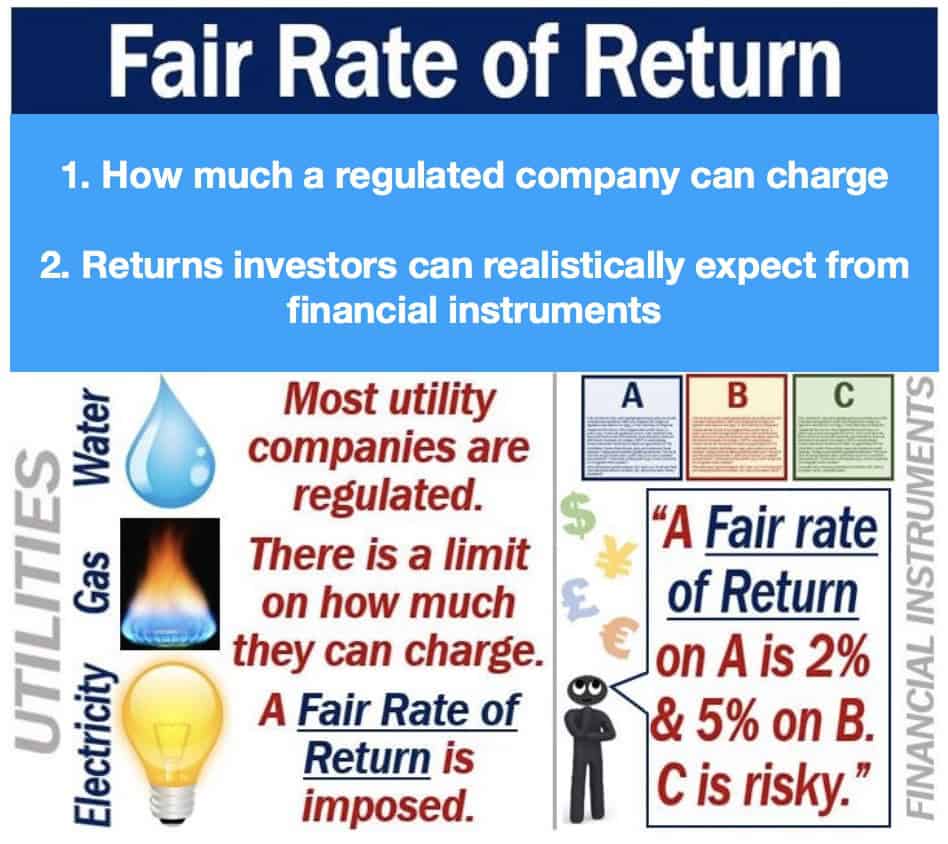A Fair Rate of Return is how much regulated companies may lawfully earn on their investments and expenditures. Public utility companies, for example, are regulated in most countries. Put simply; it is how much they can charge their customers for their services. Utility companies then use their returns, i.e., profits, to pay investors and upgrade their services.
These returns are also essential for utilities to meet regulatory compliance and environmental standards, which often require substantial financial investment
A fair rate of return also means what returns investors can realistically expect from shares, bonds, and other financial instruments.
For example, in 2017 in a sound economy, investors’ idea of a fair rate of return on bonds was approximately 2%. The United States, Canada, Western Europe, Japan, and Australasia are ‘sound economies.’
If a security has a fair rate of return, it is worth the risk, i.e., it’s a worthwhile investment.
Nasdaq.com has the following definition of the term:
“The rate of return that state governments allow a public utility to earn on its investments and expenditures.”
“Utilities then use these profits to pay investors and provide service upgrades to their customers.”
When talking about regulated companies, ‘fair’ means ‘just.’ On the other hand, when talking about financial instruments, ‘fair’ (more or less) means ‘realistic’ or ‘worthwhile.’
 We can use the term ‘fair rate of return’ for the following situations: 1. Limits on, for example, how much utility companies are allowed to charge. 2. A financial instrument (an investment) that is worth the risk has a fair rate of return.
We can use the term ‘fair rate of return’ for the following situations: 1. Limits on, for example, how much utility companies are allowed to charge. 2. A financial instrument (an investment) that is worth the risk has a fair rate of return.
Fair rate of return – risk
You can say that there is a fair rate of return when it justifies the risk.
Investors can, for example, invest their money in a super-safe security and earn a risk-free return.
If they invested in a riskier asset, on the other hand, they would expect to earn a premium. The premium would reflect the risk they would be taking.
Regarding the use of the term in the world of investing, Jahanzaib Riaz writes in quora.com:
“Hence, fair rate of return is sum of risk-free return and premiums for various risks that you are taking by making the investment.”
“Various different risks will include maturity risk, liquidity risk, default risk, inflation, country risk, equity risk, etc.”
Default risk refers to the risk of borrowers not paying back what they owe.
Fair rate of return – companies
For CEOs, a fair rate of return is a decent profit for their companies. They base their calculations on their obligations to shareholders and the business’ operating expenses.
Operating expenses include facilities maintenance, wages (payroll), and investment in business activities.
The term is common in a regulatory context, i.e., when a regulatory agency wants to limit how much a company can charge.
-
Controlling prices – advocates
Controlling maximum prices for utilities helps make them accessible for everybody, advocates argue.
The term ‘utility,’ in business, has several different meanings. In this article, utility companies are providers of water, butane/natural gas (UK: simply ‘gas’), and electricity.
-
Controlling prices – critics
Critics, on the other hand, argue that you can only get the best services in a completely free market.
‘Free market‘ means an economy where people and companies buy and sell goods and services without government interference.
Price limits on utilities are not easy to calculate. Some people say that whatever figure the government comes up with, it will be arbitrary.
Regarding an electric utility company, wisegeek.com writes:
“An electric utility, for example, may need to be able to expand capacity to serve customers, and might also need to invest in new control systems to replace outdated equipment.”
“It must have capital available to do so, and relies on customer fees to meet its needs.”
-
Public companies
If the utility company is a public company, it will also have an obligation to its shareholders.
This obligation includes not only generating sufficient profits to provide dividends but also ensuring long-term financial stability and growth to maintain shareholder trust.
A public company is one whose shares we can buy and sell freely on a stock exchange. We call it a ‘public company’ because we – the public – can buy and sell its shares.
Video – What is a Fair Rate of Return?
In this visual guide presented by our affiliate channel, Marketing Business Network on YouTube, we explain what “A Fair Rate of Return” is using straightforward language and easy-to-understand examples.
